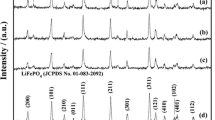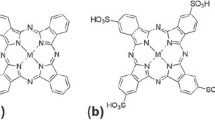Abstract
Composite electrodes based on the nitroxide free radical-contained pyrrole copolymer (PPy-co-PPy-C-TEMPO) as active material were one-step synthesized by in situ electrochemical polymerization, which was then directly applied as the cathode of lithium ion batteries. The structure, morphology, electrochemical property, and charge-discharge performances of prepared copolymers were characterized by FTIR, SEM, cyclic voltammogram, electrochemical impedance spectroscopy, and galvanostatic charge-discharge testing, respectively. The results demonstrated that PPy-co-PPy-C-TEMPO-based composite cathodes have been successfully prepared by in situ electrochemical method, and the introduction of the nitroxide free radical (TEMPO) could obviously affect the morphology and electrochemical characteristics of the obtained electroactive polymers. And the charge/discharge tests showed that with the introduction of the TEMPO, PPy-co-PPy-C-TEMPO-based composite cathodes exhibited an improved specific capacity of 70.9 mAh g−1 for PPy-co-PPy-C-TEMPO (4:1) and 62.6 mAh g−1 for PPy-co-PPy-C-TEMPO (8:1) as measured at 20 mA g−1 between 2.5 and 4.2 V, which were remarkably higher than that of the pure PPy cathode of 41.0 mAh g−1 under the same experimental conditions. Also, the obtained PPy-co-PPy-C-TEMPO copolymers demonstrated an acceptable cycling stability during the charge-discharge process. These obtained cell performances for the composite cathodes were attributed to the application of the in situ electrochemical polymerization technology, which enhanced the intimate integration between conductive polymer film and electrode. Furthermore, the introduction of TEMPO-contained pyrrole (Py-C-TEMPO) improved the morphology of the composite cathode, which was in favor of the utilization of active materials and the improved electrochemical performances.









Similar content being viewed by others
References
Poizot P, Dolhem F (2011) Clean energy new deal for a sustainable world: from non-CO2 generating energy sources to greener electrochemical storage devices. Energy Environ Sci 4:2003–2019
Liang YL, Tao ZL, Chen J (2012) Organic electrode materials for rechargeable lithium batteries. Adv Energy Mater 2:742–769
Novák P, Müller K, Santhanam KSV, Haas O (1997) Electrochemically active polymers for rechargeable batteries. Chem Rev 97:207–282
Song ZP, Zhan H, Zhou YH (2010) Polyimides: promising energy-storage materials. Angew Chem Int Ed 49:8444–8448
Oyama N, Tatsuma T, Sato T, Sotomura T (1995) Dimercaptan–polyaniline composite electrodes for lithium batteries with high energy density. Nature 373:598–600
Yao M, Senoh H, Yamazaki S, Siroma Z, Sakai T, Yasuda K (2010) High-capacity organic positive-electrode material based on a benzoquinone derivative for use in rechargeable lithium batteries. J Power Sources 195:8336–8340
Han X, Chang C, Yuan L, Sun T, Sun J (2007) Aromatic carbonyl derivative polymers as high-performance Li-ion storage materials. Adv Mater 19:1616–1621
Gall TL, Reiman KH, Grossel MC, Owen JR (2003) Poly (2,5-dihydroxy-1,4-benzoquinone-3,6-methylene): a new organic polymer as positive electrode material for rechargeable lithium batteries. J Power Sources 119-121:316–320
Zeng RH, Li XP, Qiu YC, Li WS, Yi J, Lu DS, Tan CL, Xu MQ (2010) Synthesis and properties of a lithium-organic coordination compound as lithium-inserted material for lithium ion batteries. Electrochem Commun 12:1253–1256
Suga T, Ohshiro H, Sugita S, Oyaizu K, Nishide H (2009) Emerging N-type redox-active radical polymer for a totally organic polymer-based rechargeable battery. Adv Mater 21:1627–1630
Oyaizu K, Nishide H (2009) Radical polymers for organic electronic devices: a radical departure from conjugated polymers? Adv Mater 21:2339–2344
Otero TF, Grande H, Rodríguez J (1995) A new model for electrochemical oxidation of polypyrrole under conformational relaxation control. J Electroanal Chem 394:211–216
Naoi K, Lien MM, Smyrl WH (1989) Quartz crystal microbalance analysis: part I. Evidence of anion or cation insertion into electropolymerized conducting polymers. J Electroanal Chem Interfacial Electrochem 272:273–275
Killian JG, Coffey BM, Gao F, Poehler TO, Searson PC (1996) Polypyrrole composite electrodes in an all-polymer battery system. J Electrochem Soc 143:936–942
Novák P, Vielstich W (1990) Performance of the low-current-density-synthesized polypyrrole in lithium cells containing propylene carbonate. J Electrochem Soc 137:1681–1689
Levi MD, Gofer Y, Aurbach D (2002) A synopsis of recent attempts toward construction of rechargeable batteries utilizing conducting polymer cathodes and anodes. Polym Adv Technol 13:697–713
Wang JZ, Chou SL, Liu H, Wang GX, Zhong C, Chew SY, Liu HK (2009) Highly flexible and bendable free-standing thin film polymer for battery application. Mater Lett 63:2352–2354
Su C, Ye YP, Xu LH, Zhang C (2012) Synthesis and charge-discharge properties of a ferrocene-containing polytriphenylamine derivative as the cathode of a lithium ion battery. J Mater Chem 22:22658–22662
Su C, Wang LM, Xu LH, Zhang C (2013) Synthesis of a novel ferrocene-contained polypyrrole derivative and its performance as a cathode material for Li-ion batteries. Electrochim Acta 104:302–307
Su C, Ji LL, Xu LH, Zhu XG, He HH, Lv YK, Ouyang M, Zhang C (2015) A novel ferrocene-containing aniline copolymer: its synthesis and electrochemical performance. RSC Adv 5:14053–14060
Ellis BL, Knauth P, Djenizian T (2014) Three-dimensional self-supported metal oxides for advanced energy storage. Adv Mater 26:3368–3397
Zhang S, Huang W, Hu P, Huang C, Shang C, Zhang C, Yang R, Cui G (2015) Conjugated microporous polymers with excellent electrochemical performance for lithium and sodium storage. J Mater Chem A 3:1896–1901
Zhang C, Yang X, Ren W, Wang Y, Su F, Jiang JX (2016) Microporous organic polymer-based lithium ion batteries with improved rate performance and energy density. J Power Sources 317:49–56
Sakaushi K, Nickerl G, Wisser FM, Nishio-Hamane D, Hosono E, Zhou H, Kaskel S, Eckert J (2012) An energy storage principle using bipolar porous polymeric frameworks. Angew Chem Int Ed 51:7850–7854
Nokami T, Matsuo T, Inatomi Y, Hojo N, Tsukagoshi T, Yoshizawa H, Shimizu A, Kuramoto H, Komae K, Tsuyama H, Yoshida J (2012) Polymer-bound pyrene-4,5,9,10-tetraone for fast-charge and -discharge lithium-ion batteries with high capacity. J Am Chem Soc 134:19694–19700
Walker W, Grugeon S, Vezin H, Laruelle S, Armand M, Wudl F, Tarascon JM (2011) Electrochemical characterization of lithium 4,4′-tolane-dicarboxylate for use as a negative electrode in Li-ion batteries. J Mater Chem 21:1615–1620
Tamura K, Akutagawa N, Satoh M, Wada J, Masuda T (2008) Charge/discharge properties of organometallic batteries fabricated with ferrocene-containing polymers. Macromol Rapid Commun 29:1944–1949
Nesvadba P, Folger LB, Maire P, Novák P (2011) Synthesis of a polymeric 2,5-di-t-butyl-1,4-dialkoxybenzene and its evaluation as a novel cathode material. Synth Met 161:259–262
Zhang DC, Zhang X, Chen Y, Yu P, Wang CH, Ma YW (2011) Enhanced capacitance and rate capability of graphene/polypyrrole composite as electrode material for supercapacitors. J Power Sources 196:5990–5996
Xu LH, Yang F, Su C, Ji LL, Zhang C (2014) Synthesis and properties of novel TEMPO-contained polypyrrolederivatives as the cathode material of organic radical battery. Electrochim Acta 130:148–155
Liu A, Li C, Bai H, Shi G (2010) Electrochemical deposition of polypyrrole/sulfonated graphene composite films. J Phys Chem C 114:22783–22789
Wang SW, Wang LJ, Zhang K, Zhu ZQ, Tao ZL, Chen J (2013) Organic Li4C8H2O6 nanosheets for lithium-ion batteries. Nano Lett 13:4404–4409
Nagarathinam M, Saravanan K, Phua EJH, Reddy MV, Chowdari BVR, Vittal JJ (2012) Redox-active metal-centered oxalato phosphate open framework cathode materials for lithium ion batteries. Angew Chem 124:1–6
Chen Y, Zeng S, Qian JF, Wang YD, Cao YL, Yang HX, Ai XP (2014) Li-conductive polymer-embedded nano-Si particles as anode material for advanced Li-ion batteries. ACS Appllied Mater Interfaces 6:3508–3512
Biswas S, Drzal LT (2010) Multilayered nanoarchitecture of graphene nanosheets and polypyrrole nanowires for high performance supercapacitor electrodes. Chem Mater 22:5667–5671
Acknowledgements
The project was supported by the National Science Foundation of China (Grant No. 51573099); the Natural Science Foundation of Liaoning Province, China (Grant No. 2015020441, No. 201602591); and the National Science Foundation for Post-doctoral Scientists of China (Grant No. 2015M570524). This work also was supported by the analysis and testing foundation of Zhejiang University of Technology.
Author information
Authors and Affiliations
Corresponding authors
Rights and permissions
About this article
Cite this article
Xu, L., Guo, P., He, H. et al. Preparation of TEMPO-contained pyrrole copolymer by in situ electrochemical polymerization and its electrochemical performances as cathode of lithium ion batteries. Ionics 23, 1375–1382 (2017). https://doi.org/10.1007/s11581-016-1965-x
Received:
Revised:
Accepted:
Published:
Issue Date:
DOI: https://doi.org/10.1007/s11581-016-1965-x




